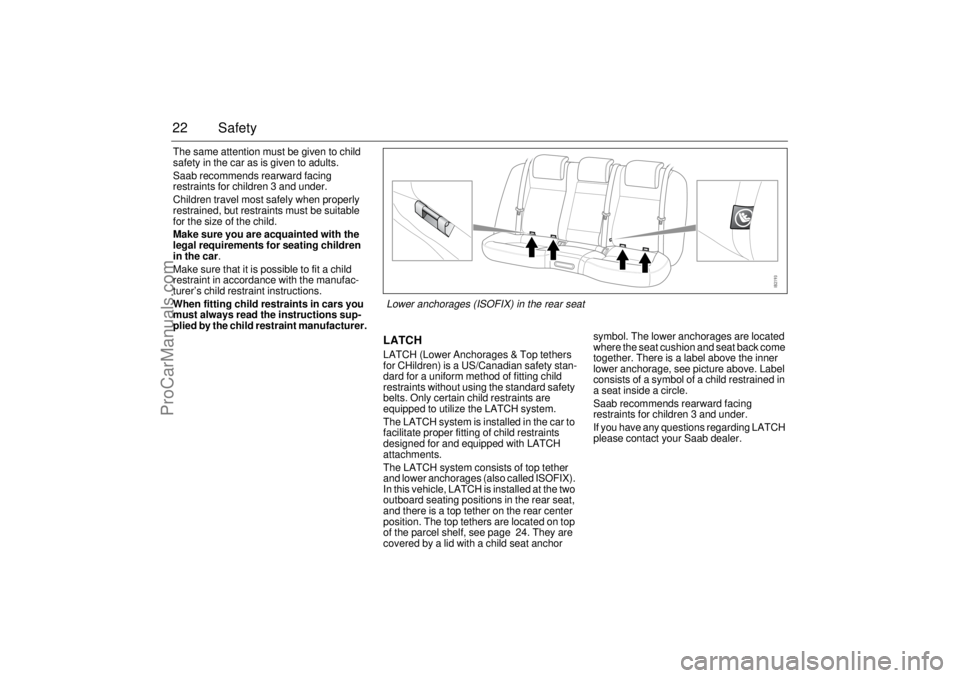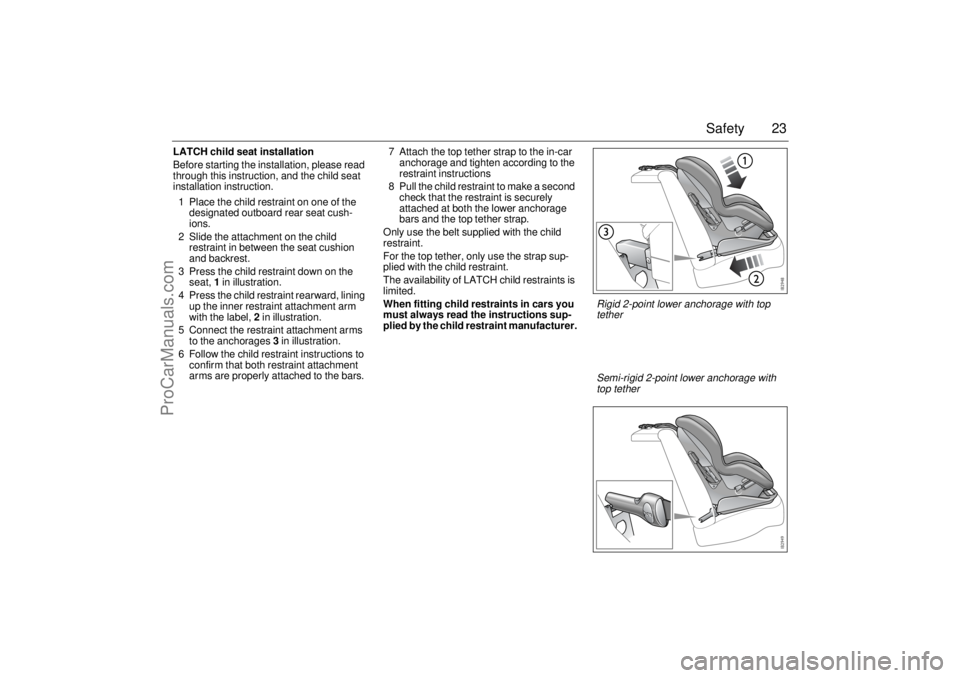Page 14 of 256

14 SafetySafety belt use during pregnancyPregnant women must always wear a
safety belt to protect both themselves and
the unborn child.
The lap belt should be placed low, across
the hips and over the upper thighs.
Safety belt pretensioners
The belts of the front seats are fitted with
automatic pretensioners and force limiters.
The pretensioners are activated in the event
of a violent frontal or side-on crash. The
pretensioners are only activated if the safety
belt in question is in use.
The safety belt pretensioners are not acti-
vated if the car rolls over.
The safety belt pretensioners serve to
reduce the forward movement of the body
by tensioning the belt. The force limiters
reduce belt loads on the body by "slacken-
ing" the safety belt slightly to absorb the
body’s kinetic energy as gradually as possi-
ble.
WARNING
If the car is involved in a crash, the safety
belts, belt pretensioners and other
components must be inspected by an
authorized Saab dealer and replaced as
necessary.
Never make any alterations or repairs to
the safety belt yourself. Visit an autho-
rized Saab dealer for any necessary
repairs.
ProCarManuals.com
Page 15 of 256

15 Safety
Safety belts, rear seatThe three rear seats all have three-point
safety belts with inertia reels.
Fasten the belts by pulling the belt across
you and inserting the tongue into the buckle.
Check that it is securely fastened.
Grasp the shoulder belt close to the buckle
and pull the belt towards the shoulder to
tighten the lap belt part.
The belt must be as far in on the shoulder as
possible.
Press the red button on the buckle to
release the belt.See page 217 for the checking of belt func-
tion, cleaning, etc.
WARNING
Make sure that the belt does not
become trapped when the backrest is
folded down or raised (see page 116).
If a cargo has to be placed on a seat,
it must be properly secured with the
safety belt. This reduces the risk of the
cargo being thrown about during hard
braking or a crash, which could cause
personal injury.
Check that the belt is not twisted or
lying against sharp edges.
Make sure you use the correct safety
belt buckle. The buckles for the center
and left-hand rear seats are close
together.
Rear safety belts
Securing an item on the rear seat
ProCarManuals.com
Page 17 of 256
17 Safety
Backrest rake angleTo find the most comfortable position, turn
the knob to provide stepless adjustment of
the backrest.
Lumbar supportAdjust the firmness of the lumbar support by
turning the knob.
WARNING
The backrest should be upright during
driving, so that the safety belt, airbag and
backrest can provide optimum protection
in the event of emergency braking or a
crash, in particular a rear-end collision.
Adjusting the backrest
ProCarManuals.com
Page 19 of 256

19 Safety
Backrest rake angleAdjust the rake angle of the backrest with
the rear lever.
Lumbar support, driver’s seatAdjust the firmness of the lumbar support by
turning the knob.
Memory function (option)The legroom of the driver’s seat with
memory can always be adjusted, irrespec-
tive of whether or not one of the front doors
is open. Nor does the position of the ignition
switch make any difference. If the ignition is
ON, all adjustments can be made. When a
front door is open, all seat settings can be
adjusted for up to 20 minutes.
The memory also includes the door mirror
settings.
Storing and restoring settings
1 Adjust the seat and the door mirrors.
The lumbar support is not included by
the memory function.
2 Press and hold the M-button and then
press one of the preselect buttons (1, 2
or 3). A chime will sound to confirm that
the settings have been saved.
WARNING
The backrest should be upright during
driving, so that the safety belt, airbag and
backrest can provide optimum protection
in the event of emergency braking or a
crash, in particular a rear-end collision.
ProCarManuals.com
Page 21 of 256

21 Safety
Child safety
Protect your children from getting
trapped in the trunk of a car
WARNING
Children must always be suitably
restrained in the car.
DEATH or SERIOUS
INJURY can occur
Children 12 and under or
shorter than 55 inches
(140 cm) can be killed by the airbag
The BACK SEAT is the SAFEST place
for children
NEVER put a rear-facing child seat in
the front
Sit as far back as possible from the
airbag
ALWAYS use SAFETY BELTS and
CHILD RESTRAINTS
WARNING
Never leave your children unattended
in a car, even for a short time.
– Children can suffer heat stroke,
perhaps die, in a matter of minutes.
– Children can put the car into gear and
hurt themselves or others.
At gas stations, take the remote
control from the car while filling the
tank.
Never allow children to climb on top of
or under motor vehicles.
Always look for children before back-
ing your motor vehicle out of a garage
or driveway.
To avoid carbon monoxide poisoning,
never let a car idle in the garage.
Supervise young children around
buckets of water while washing your
car. Small children can drown in
seconds in less than an inch of water.
WARNING
Teach your children not to play in or
around cars.
Watch your children when loading or
unloading the car so they don´t get
locked in by mistake.
Always lock the doors and trunk of
your car, and keep the keys out of chil-
dren´s sight and reach.
Keep the rear fold-down seat closed to
help prevent children from getting into
the trunk from inside the car.
ProCarManuals.com
Page 22 of 256

22 SafetyThe same attention must be given to child
safety in the car as is given to adults.
Saab recommends rearward facing
restraints for children 3 and under.
Children travel most safely when properly
restrained, but restraints must be suitable
for the size of the child.
Make sure you are acquainted with the
legal requirements for seating children
in the car.
Make sure that it is possible to fit a child
restraint in accordance with the manufac-
turer’s child restraint instructions.
When fitting child restraints in cars you
must always read the instructions sup-
plied by the child restraint manufacturer.
LATCHLATCH (Lower Anchorages & Top tethers
for CHildren) is a US/Canadian safety stan-
dard for a uniform method of fitting child
restraints without using the standard safety
belts. Only certain child restraints are
equipped to utilize the LATCH system.
The LATCH system is installed in the car to
facilitate proper fitting of child restraints
designed for and equipped with LATCH
attachments.
The LATCH system consists of top tether
and lower anchorages (also called ISOFIX).
In this vehicle, LATCH is installed at the two
outboard seating positions in the rear seat,
and there is a top tether on the rear center
position. The top tethers are located on top
of the parcel shelf, see page 24. They are
covered by a lid with a child seat anchor symbol. The lower anchorages are located
where the seat cushion and seat back come
together. There is a label above the inner
lower anchorage, see picture above. Label
consists of a symbol of a child restrained in
a seat inside a circle.
Saab recommends rearward facing
restraints for children 3 and under.
If you have any questions regarding LATCH
please contact your Saab dealer.Lower anchorages (ISOFIX) in the rear seat
ProCarManuals.com
Page 23 of 256

23 Safety
LATCH child seat installation
Before starting the installation, please read
through this instruction, and the child seat
installation instruction.
1 Place the child restraint on one of the
designated outboard rear seat cush-
ions.
2 Slide the attachment on the child
restraint in between the seat cushion
and backrest.
3 Press the child restraint down on the
seat, 1 in illustration.
4 Press the child restraint rearward, lining
up the inner restraint attachment arm
with the label, 2 in illustration.
5 Connect the restraint attachment arms
to the anchorages 3 in illustration.
6 Follow the child restraint instructions to
confirm that both restraint attachment
arms are properly attached to the bars.7 Attach the top tether strap to the in-car
anchorage and tighten according to the
restraint instructions
8 Pull the child restraint to make a second
check that the restraint is securely
attached at both the lower anchorage
bars and the top tether strap.
Only use the belt supplied with the child
restraint.
For the top tether, only use the strap sup-
plied with the child restraint.
The availability of LATCH child restraints is
limited.
When fitting child restraints in cars you
must always read the instructions sup-
plied by the child restraint manufacturer.
Rigid 2-point lower anchorage with top
tether
Semi-rigid 2-point lower anchorage with
top tether
ProCarManuals.com
Page 24 of 256

24 SafetyChild tether anchorages for forward
facing child seatsChild restraints with a tether strap must be
attached according to Canadian and U.S.
safety standards.The car is provided with three top tether
anchorages. Use the one that is right behind
the child restraint and attach the restraint as
follows:
1 Open the cover that is right behind the
child restraint, 1 in illustration.
2 Place the child restraint in the rear seat.
3 Secure the lower part of the child
restraint by means of the lower anchor-
ages (ISOFIX) or the safety belts as
described in the child restraint installa-
tion instruction.
4 Lower the headrest and route the tether
over it.
5 Attach the tether to the anchorage, 2 in
illustration.
6 Close the cover to the middle position, 3
in illustration.7 Tighten the tether so that the back of the
child restraint is pressed hard against
the backrest.
8 Pull the child restraint to make a second
check that the restraint is securely
attached at both the lower anchorages
bars on the safety belts and the top
tether strap.
WARNING
Child top tether anchorages are designed
to withstand only those loads imposed by
correctly fitted child restraints.
Under no circumstances are they to be
used for adult safety belts.
Child tether anchorages in parcel shelf
ProCarManuals.com